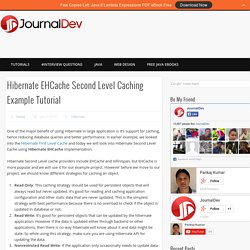

Hibernate EHCache Second Level Caching Example Tutorial. One of the major benefit of using Hibernate in large application is it’s support for caching, hence reducing database queries and better performance.

In earlier example, we looked into the Hibernate First Level Cache and today we will look into Hibernate Second Level Cache using Hibernate EHCache implementation. Hibernate Second Level cache providers include EHCache and Infinispan, but EHCache is more popular and we will use it for our example project. However before we move to our project, we should know different strategies for caching an object. Read Only: This caching strategy should be used for persistent objects that will always read but never updated. It’s good for reading and caching application configuration and other static data that are never updated.
Since EHCache supports all the above caching strategies, it’s the best choice when you are looking for second level caching in hibernate. Let’s look into each component of the application one by one. EHCache Configuration File. Implement Simple Threadsafe Cache using HashMap without using Synchronized Collection. Yet Another Java Blog: Intro to Caching,Caching algorithms and caching frameworks part 1. A lot of us heard the word cache and when you ask them about caching they give you a perfect answer but they don’t know how it is built, or on which criteria I should favor this caching framework over that one and so on, in this article we are going to talk about Caching, Caching Algorithms and caching frameworks and which is better than the other.

The Interview: "Caching is a temp location where I store data in (data that I need it frequently) as the original data is expensive to be fetched, so I can retrieve it faster. " That what programmer 1 answered in the interview (one month ago he submitted his resume to a company who wanted a java programmer with a strong experience in caching and caching frameworks and extensive data manipulation) Interviewer: Nice and based on what criteria do you choose your caching solution?
Programmer 1 :huh, (thinking for 5 minutes) , mmm based on, on , on the data (coughing…) Interviewer: excuse me! Programmer 1: data?! Programmer 1: capacity? What is Cache? Top 10 Java Caching Sotware. Java caching software is written in java for server-side java applications.

Caching is an effective technique when it comes to long-running applications such as servlets, JSPs and GUI applications. It speeds up the dynamic web applications by providing a means to manage cached data of various dynamic natures. At times its inevitable to cache some Java objects, especially the data that takes too much time to recreate when it is not changed frequently. For the ease of use these can be objects in a hash table, given that it takes the ever-increasing memory footprint of your application.
This allows you to expire the older objects in the hashtable time and again, since you can recreate them whenever needed. Now there are sites that construct pages, dropdowns, or common search results form a database repeatedly at regular intervals. 1. It features a SimplePageCachingFilter for caching the static pages. Link 2. It’s one of the popular high performance J2EE caching solutions. Link 3. Link. JCS – Java Caching System. Java Caching System JCS is a distributed caching system written in Java.

It is intended to speed up applications by providing a means to manage cached data of various dynamic natures. Like any caching system, JCS is most useful for high read, low put applications. Latency times drop sharply and bottlenecks move away from the database in an effectively cached system. Learn how to start using JCS. The JCS goes beyond simply caching objects in memory. JCS 2.0 works on JDK versions 1.6 and up. JCS is a Composite Cache The foundation of JCS is the Composite Cache, which is the pluggable controller for a cache region. The JCS jar provides production ready implementations of each of the four types of caches. LRU Memory Cache The LRU Memory Cache is an extremely fast, highly configurable memory cache . Indexed Disk Cache The Indexed Disk Cache is a fast, reliable, and highly configurable swap for cached data. JDBC Disk Cache.